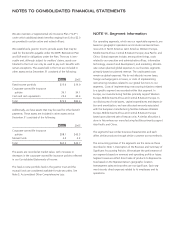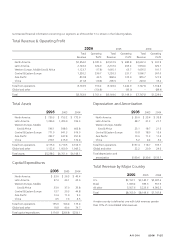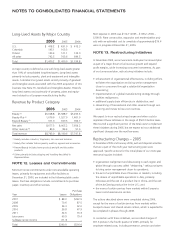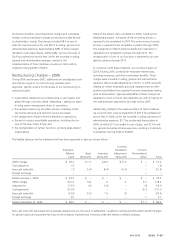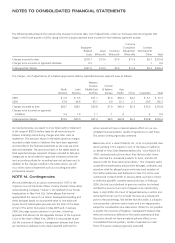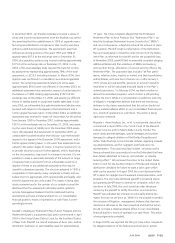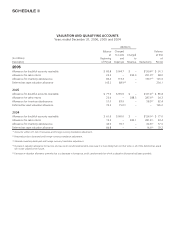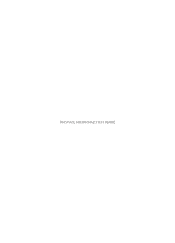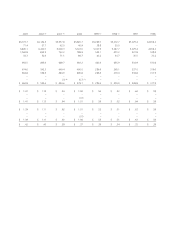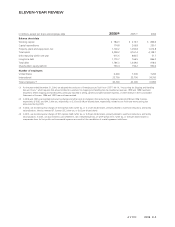Avon 2006 Annual Report Download - page 79
Download and view the complete annual report
Please find page 79 of the 2006 Avon annual report below. You can navigate through the pages in the report by either clicking on the pages listed below, or by using the keyword search tool below to find specific information within the annual report.In December 2002, our Brazilian subsidiary received a series of
excise and income tax assessments from the Brazilian tax author-
ities asserting that the establishment in 1995 of separate manu-
facturing and distribution companies in that country was done
without a valid business purpose. The assessments assert tax
deficiencies during portions of the years 1997 and 1998 of
approximately $97.0 at the exchange rate on December 31,
2006, plus penalties and accruing interest totaling approximately
$175.0 at the exchange rate on December 31, 2006. In July
2003, a first-level appellate body rejected the basis for income
tax assessments representing approximately 78% of the total
assessment, or $213.0 (including interest). In March 2004, that
rejection was confirmed in a mandatory second-level appellate
review. The remaining assessments relating to excise taxes
(approximately $59.0) were not affected. In December 2003, an
additional assessment was received in respect of excise taxes for
the balance of 1998, totaling approximately $122.0 at the
exchange rate on December 31, 2006, and asserting a different
theory of liability based on purported market sales data. In Jan-
uary 2005, an unfavorable first administrative level decision was
received with respect to the appeal of that assessment and a
further appeal has been taken. In December 2004, an additional
assessment was received in respect of excise taxes for the period
from January 1999 to December 2001, totaling approximately
$267.0 at the exchange rate on December 31, 2006, and assert-
ing the same theory of liability as in the December 2003 assess-
ment. We appealed that assessment. In September 2005, an
unfavorable first administrative level decision was received with
respect to the appeal of the December 2004 assessment, and a
further appeal is being taken. In the event that assessments are
upheld in the earlier stages of review, it may be necessary for us
to provide security to pursue further appeals, which, depending
on the circumstances, may result in a charge to income. It is not
possible to make a reasonable estimate of the amount or range
of expense that could result from an unfavorable outcome in
respect of these or any additional assessments that may be
issued for subsequent periods. The structure adopted in 1995 is
comparable to that used by many companies in Brazil, and we
believe that it is appropriate, both operationally and legally, and
that the assessments are unfounded. This matter is being vigo-
rously contested and in the opinion of our outside counsel the
likelihood that the assessments ultimately will be upheld is
remote. Management believes that the likelihood that the
assessments will have a material impact on our consolidated
financial position, results of operations or cash flows is corre-
spondingly remote.
Kendall v. Employees’ Retirement Plan of Avon Products and the
Retirement Board is a purported class action commenced in April
2003 in the United States District Court for the Southern District
of New York. Plaintiff is a retired employee of Avon who, before
retirement, had been on paid disability leave for approximately
19 years. The initial complaint alleged that the Employees’
Retirement Plan of Avon Products (the “Retirement Plan”) vio-
lated the Employee Retirement Income Security Act (“ERISA”)
and, as a consequence, unlawfully reduced the amount of plain-
tiff’s pension. Plaintiff sought a reformation of the Retirement
Plan and recalculation of benefits under the terms of the Retire-
ment Plan, as reformed for plaintiff and for the purported class.
In November 2003, plaintiff filed an amended complaint alleging
additional Retirement Plan violations of ERISA and seeking,
among other things, elimination of a social security offset in the
Retirement Plan. The purported class includes “all Plan partic-
ipants, whether active, inactive or retired, and their beneficiaries
and/or Estates, with one hour of service on or after January 1,
1976, whose accrued benefits, pensions or survivor’s benefits
have been or will be calculated and paid based on the Plan’s
unlawful provisions.” In February 2004, we filed a motion to
dismiss the amended complaint, which motion is still pending
before the court. While it is not possible to predict the outcome
of litigation, management believes that there are meritorious
defenses to the claims asserted and that this action should not
have a material adverse effect on our consolidated financial posi-
tion, results of operations or cash flows. This action is being
vigorously contested.
Roqueta v. Avon Products, Inc., et al. is a purported class action
commenced in April 2005 in the Circuit Court of the Eleventh
Judicial Circuit in and for Miami-Dade County, Florida. The
action seeks general damages, special damages and punitive
damages for alleged violations of the Florida Deceptive and
Unfair Trade Practices Act and Florida statutes regarding mislead-
ing advertisements, and for negligent and fraudulent mis-
representation. The purported class includes “all persons who
have purchased skin care products from the Defendant that have
been falsely advertised to have an ‘anti-cellulite’ or cellulite
reducing effect.” We removed the action to the United States
District Court for the Southern District of Florida and moved to
dismiss the complaint for failure to state a claim upon which
relief can be granted. In August 2005 the court dismissed plain-
tiff’s claims for negligent and fraudulent misrepresentation, with
prejudice. The court also dismissed plaintiff’s remaining claims
but granted plaintiff leave to amend her complaint, which she
has done. In July 2006, the court issued an order denying a
motion by the plaintiff to certify this action as a class action.
Plaintiff has indicated her intention to voluntarily dismiss the
matter but has not yet done so. While it is not possible to predict
the outcome of litigation, management believes that there are
meritorious defenses to the claims asserted and that this action
should not have a material adverse effect on our consolidated
financial position, results of operations or cash flows. This action
is being vigorously contested.
In August 2005, we reported the filing of class action complaints
for alleged violations of the federal securities laws in actions
A V O N 2006 F-29







